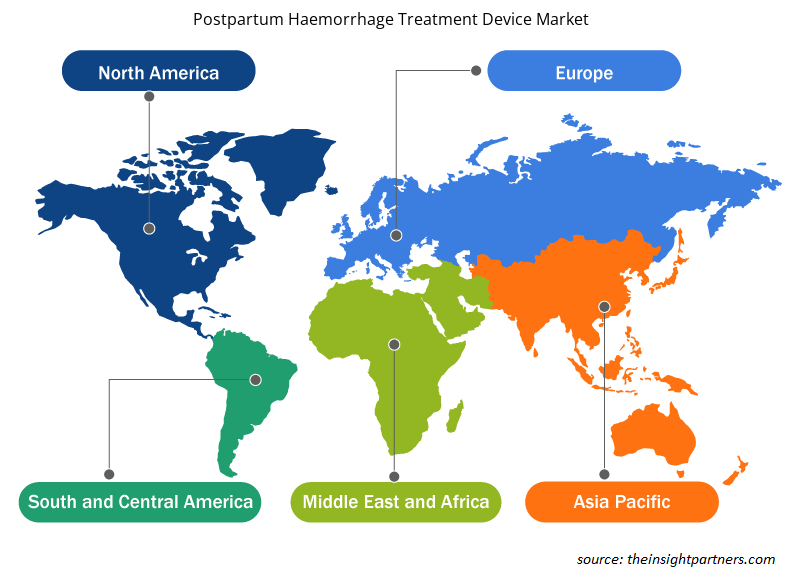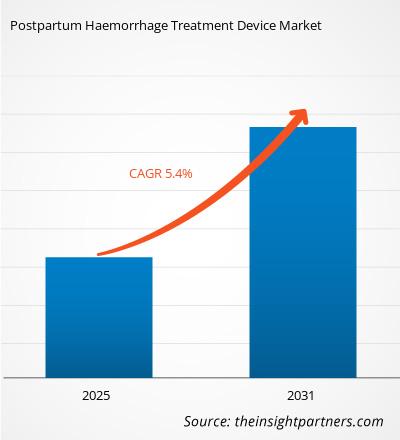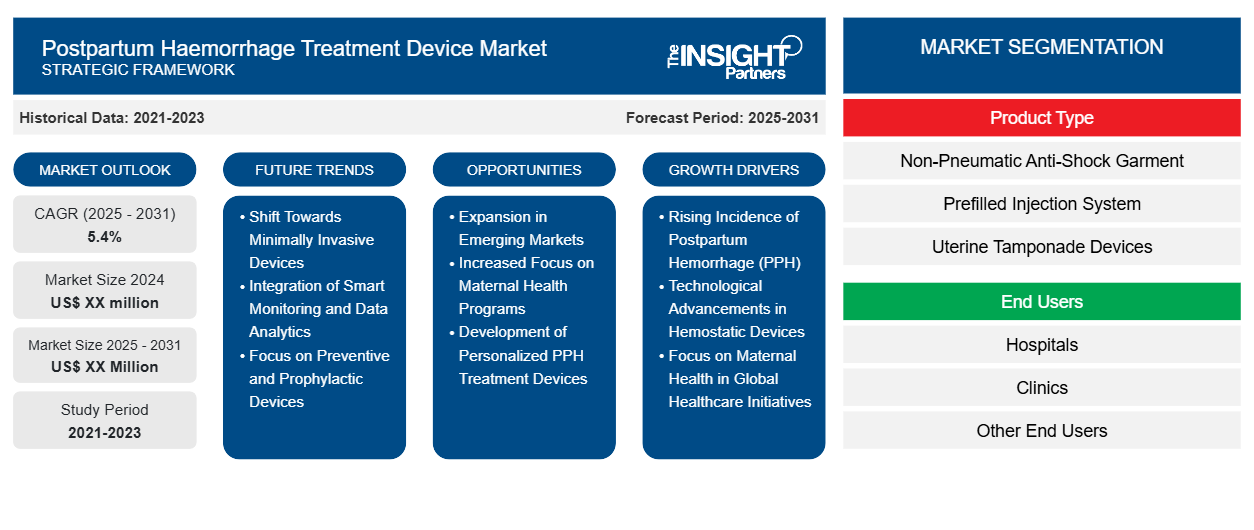产后出血治疗设备市场预计在 2024 年至 2031 年期间的复合年增长率为 5.4%,市场规模将从 2024 年的 XX 百万美元扩大到 2031 年的 XX 百万美元。
报告按产品类型(非气动防休克服、预充注射系统和子宫填塞装置)、最终用户(医院、诊所和其他最终用户)细分
报告目的
The Insight Partners 撰写的《产后出血治疗设备市场》报告旨在描述当前形势和未来增长、主要驱动因素、挑战和机遇。这将为各种业务利益相关者提供见解,例如:
- 技术提供商/制造商:了解不断变化的市场动态并了解潜在的增长机会,从而能够做出明智的战略决策。
- 投资者:对市场增长率、市场财务预测以及整个价值链中存在的机会进行全面的趋势分析。
- 监管机构:监管市场政策和警察活动,旨在最大限度地减少滥用行为,维护投资者的信任和信心,维护市场的完整性和稳定性。
产后出血治疗设备市场细分
产品类型
- 非气动防冲击服
- 预充式注射系统
- 子宫填塞装置
最终用户
- 医院
- 诊所
- 其他最终用户
定制此报告以满足您的需求
您可以免费定制任何报告,包括本报告的部分内容、国家级分析、Excel 数据包,以及为初创企业和大学提供优惠和折扣
- 获取此报告的关键市场趋势。这个免费样品将包括数据分析,从市场趋势到估计和预测。
产后出血治疗设备市场增长动力
- 产后出血 (PPH) 发病率上升:市场发展的主要原因之一是产后出血 (PPH) 病例的增加,尤其是在产妇保健服务较差的发展中国家。高龄产妇、多次怀孕和选择性剖腹产是导致 PPH 病例增加的一些原因。这种对医疗保健问题的担忧增加了对专门治疗设备的需求,包括宫内球囊和局部止血剂,以减少与该病症相关的死亡。
- 止血设备的技术进步:压力传感子宫球囊和止血能量设备等止血设备的改进对产后出血治疗设备市场产生了积极影响。这些现代设备由于其温和的非侵入性和易用性,临床医生可以快速使用这些设备来管理产后出血,从而减少并发症并改善患者护理。因此,市场范围正在不断扩大。
- 全球医疗保健计划关注产妇健康:推动产后出血治疗设备市场发展的另一个关键因素是,特别是在发展中国家的卫生系统中,产妇健康结果的改善趋势正在发生变化。政府、非政府以及国际机构都关注预防产妇死亡,尤其是产后出血。这导致医院和诊所使用治疗系统和程序的增加,从而导致市场增长。
产后出血治疗设备市场未来趋势
- 转向微创设备:产后出血 (PPH) 治疗设备市场中增长最快的趋势之一是转向微创选择。子宫球囊填塞术和其他类似设备已经开发出来,有助于以较少的手术控制出血。这些系统降低了风险,加快了愈合过程,并提供了更安全的约束 PPH 的替代方法,因此在临床上更受先进和资源匮乏地区的青睐。
- 智能监控与数据分析的整合:在产后出血治疗设备中,另一个新兴趋势是使用智能技术和数据。更先进的传感器监控设备可以即时提供子宫收缩水平、出血估计和患者其他生命体征的结果。这些技术不仅有助于更好地管理药物、评估干预效果,还有助于更好地进行产妇护理,从而推动这些设备的发展。
- 重点关注预防和预防设备:人们注意到,人们越来越关注开发和制造用于预防产后出血的此类设备。人们正在寻求将此类有助于控制出血(尤其是在分娩前或分娩后)的设备纳入正常分娩过程。其他发展是积极措施,例如旨在在情况发生之前纠正情况的措施,这些措施包括早期预警装置以及用于高风险妊娠或原发性产后出血 (PPH) 女性的子宫压迫装置。
产后出血治疗设备市场机会
- 新兴市场的扩张:产后出血 (PPH) 治疗设备市场在发展中国家具有很高的发展前景,这些国家由于缺乏现代医疗设备而导致产妇死亡率较高。由于亚太、非洲和拉丁美洲地区的医疗保健系统有所改善,对治疗 PPH 的平价且可用的设备的需求将会增加,这为市场的增长和覆盖服务尚未覆盖的国家创造了途径。
- 更加关注产妇保健计划:由于全球致力于改善妇女健康,PPH 治疗设备市场前景广阔。由于世界卫生组织等机构表示需要控制产妇发病率和死亡率,对先进和动态 PPH 设备的需求将不断增加。低成本 Dunbar 设备可进一步增强低产妇中心的需求。
- 个性化产后出血治疗设备的开发:随着个性化医疗概念的广泛接受,设计回顾性产后出血治疗设备的机会也随之而来。例如,这种设备还可以考虑子宫张力、出血程度和患者的合并症。因此,专注于精准医疗的创新和治疗策略似乎有望预防和管理产后出血,并改善产妇健康,为开发和市场开辟道路。
产后出血治疗设备市场区域洞察
Insight Partners 的分析师已详尽解释了预测期内影响产后出血治疗设备市场的区域趋势和因素。本节还讨论了北美、欧洲、亚太地区、中东和非洲以及南美和中美洲的产后出血治疗设备市场细分和地理位置。

- 获取产后出血治疗设备市场的区域特定数据
产后出血治疗设备市场报告范围
| 报告属性 | 细节 |
|---|---|
| 2024 年的市场规模 | XX 百万美元 |
| 2031 年市场规模 | XX 百万美元 |
| 全球复合年增长率(2025 - 2031) | 5.4% |
| 史料 | 2021-2023 |
| 预测期 | 2025-2031 |
| 涵盖的领域 | 按产品类型
|
| 覆盖地区和国家 | 北美
|
| 市场领导者和主要公司简介 |
|
产后出血治疗设备市场参与者密度:了解其对业务动态的影响
产后出血治疗设备市场正在快速增长,这得益于终端用户需求的不断增长,而这些需求又源于消费者偏好的不断变化、技术进步以及对产品优势的认识不断提高等因素。随着需求的增加,企业正在扩大其产品范围,进行创新以满足消费者的需求,并利用新兴趋势,从而进一步推动市场增长。
市场参与者密度是指在特定市场或行业内运营的企业或公司的分布情况。它表明在给定市场空间中,相对于其规模或总市场价值,有多少竞争对手(市场参与者)存在。
在产后出血治疗设备市场运营的主要公司有:
- 库克医疗
- 屋宇署
- 犹他医疗产品有限公司
- 抗菌防菌
- Alydia 健康
免责声明:上面列出的公司没有按照任何特定顺序排列。

- 了解产后出血治疗设备市场顶级关键参与者概览
主要卖点
- 全面覆盖:报告全面涵盖了产后出血治疗设备市场的产品、服务、类型和最终用户的分析,提供了整体概况。
- 专家分析:报告基于对行业专家和分析师的深入了解而编写。
- 最新信息:该报告涵盖了最新信息和数据趋势,确保了其与业务的相关性。
- 定制选项:此报告可以定制以满足特定客户要求并恰当地适应业务策略。
因此,产后出血治疗设备市场研究报告有助于引领解读和了解行业情景和增长前景。尽管可能存在一些合理的担忧,但本报告的总体优势往往大于劣势。
- 历史分析(2 年)、基准年、预测(7 年)及复合年增长率
- PEST和SWOT分析
- 市场规模、价值/数量 - 全球、区域、国家
- 行业和竞争格局
- Excel 数据集
近期报告
客户评价
购买理由
- 明智的决策
- 了解市场动态
- 竞争分析
- 客户洞察
- 市场预测
- 风险规避
- 战略规划
- 投资论证
- 识别新兴市场
- 优化营销策略
- 提升运营效率
- 顺应监管趋势





















 获取免费样品 - 产后出血治疗设备市场
获取免费样品 - 产后出血治疗设备市场